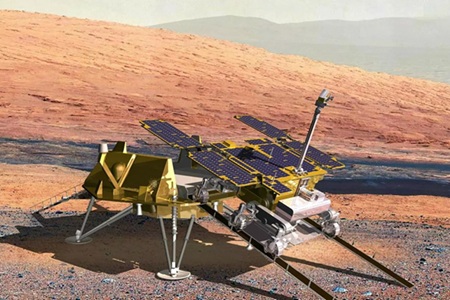 Airbus has been chosen by the European Space Agency (ESA) and Thales Alenia Space (TAS), the ExoMars industrial prime contractor, to develop crucial systems for the ExoMars lander. This lander will safely deliver the Rosalind Franklin rover to the Martian surface.
Airbus has been chosen by the European Space Agency (ESA) and Thales Alenia Space (TAS), the ExoMars industrial prime contractor, to develop crucial systems for the ExoMars lander. This lander will safely deliver the Rosalind Franklin rover to the Martian surface.
Following atmospheric entry, descent and a parachute-assisted braking phase, the Airbus-built landing platform will ensure a controlled touchdown on Mars and facilitate the rover’s deployment onto the surface.
Kata Escott, Managing Director of Airbus Defence and Space UK said: “Getting the Rosalind Franklin rover onto the surface of Mars is a huge international challenge and the culmination of more than 20 years’ work. We are proud to have built the rover in our state-of-the-art Stevenage cleanroom and delighted now to develop the project to ensure its safe delivery to Mars. Rosalind Franklin will be the first Martian rover able to analyse samples from two metres below the surface in its search for past or present life. The mission will supercharge our space know-how in the UK, and will advance our collective understanding of our solar system.”
UK Technology Secretary Peter Kyle added: “This inspiring example of world-class British science will bring us one step closer to answering long-asked questions on potential life on Mars. Landing the first ever home-grown rover on Mars, Airbus will not only help Britain make history and lead the European space race but also bring hundreds of highly skilled jobs and investment as we secure Britain’s future through our Plan for Change.”
Under TAS’s leadership, Airbus teams in Stevenage will design the mechanical, thermal and propulsion systems essential for a safe landing in 2030. This includes the landing structure, a propulsion system for final braking thrust, and landing gear to stabilise the lander upon touchdown. The platform will feature two deployable ramps on opposite sides, allowing the rover to select the safest descent route onto the Martian surface.
Airbus engineers in Stevenage have built over 120 propulsion systems for more than 90 spacecraft, supporting telecoms, Earth observation, science and exploration missions. The ExoMars system will use retro rockets to reduce the lander’s descent speed from 45m/s after the parachute phase to under 3m/s before touchdown.
Airbus originally designed and built the Rosalind Franklin rover in its bio-burden cleanroom in Stevenage, delivering it to TAS in 2019. While the mission was initially scheduled for launch in 2022, it was postponed due to the Russian-Ukraine conflict.
Now, Airbus is collaborating with TAS, ESA and NASA to upgrade the rover ahead of its revised 2028 launch on a NASA-supplied rocket. Updates include integrating NASA’s Radioisotope Heater Units (RHUs) to maintain warmth on Mars and introducing a software mode that enables the rover to quickly transition to autonomous operation after landing. The mission is scheduled to land in 2030, strategically avoiding the planet’s global dust season.














Add Comment